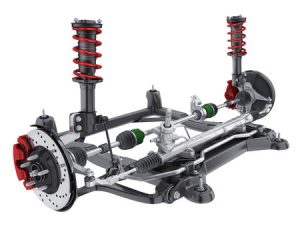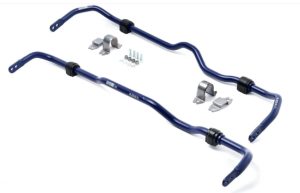Modern suspension systems rely on the combined efforts of springs, shock absorbers, and stabilizer (sway) bars. Together, they maintain ride comfort, handling precision, and vehicle safety. This article explores how these components work in tandem and why maintaining them is essential — even offering tips and a link to Buy Stabilizer & Components online.
Suspension System Overview

| Component | Primary Role |
|---|---|
| Springs | Support vehicle weight, absorb impacts from road irregularities |
| Shock Absorbers | Dampen spring oscillations, ensuring steady ride and road contact |
| Stabilizer Bars | Reduce body roll during cornering by linking suspension across the axle |
-
Springs carry the load and absorb road shocks.
-
Shocks (dampers) control spring oscillations.
-
Stabilizer bars resist uneven wheel movement, keeping the chassis level.
Springs: The Suspension’s Foundation
-
Coil or leaf springs compress under load, absorbing bumps.
-
Air springs offer adjustability based on ride conditions.
-
While excellent at energy absorption, springs can cause bouncing — requiring shock absorbers to control motion.
Shock Absorbers: Oscillation Smoothers
-
Filled with hydraulic fluid (or gas), shocks dissipate energy as heat.
-
Without shocks, springs would oscillate uncontrollably, leading to poor control.
-
Shocks also help stabilizer bars by maintaining consistent tire contact and damping roll.
Stabilizer Bars: Minimizing Roll, Maximizing Control
-
A torsion bar linking left and right suspension, it twists under load.
-
In cornering, the outside wheel pushes down more, twisting the bar and resisting roll.
-
Mounted via bushings and end links, bars apply corrective force to maintain balance.
The Interactive Dynamics
When a body rolls during a turn:
-
Springs compress on the outside, extend inside.
-
Shock absorbers dampen that motion, preventing oscillation.
-
Stabilizer bars — since one wheel moves differently than the other — twist and apply force to counteract the roll.
Together, they ensure the chassis remains level, improving grip, steering precision, and comfort.
Coordinated Suspension Behaviors
| Scenario | Spring Action | Shock Action | Stabilizer Bar Reaction |
|---|---|---|---|
| Cornering | Outside compresses | Dampen tilt | Twists to resist roll and balance chassis |
| Braking | Front springs compress | Prevent dive with damping | Adds stiffness to reduce front-end dive |
| Bumps | Wheel compresses spring | Smooths rebound | Minimal; springs/shocks manage bump force |
| Uneven road surface | One wheel dips, other lifts | Dampens oscillations | Limits unwanted pitch from quick surface changes |
Tuning the Suspension Triangle
Proper tuning requires balancing three components:
-
Spring rate: Determines stiffness and ride height.
-
Shock damping: Affects comfort and roll control.
-
Stabilizer bar stiffness: Controls roll resistance but too stiff can reduce comfort.
Tuning Checklist
-
Upgraded springs? Consider firmer shocks and adjustable stabilizer bars.
-
Reduced bounce? Check that shock stiffness matches spring rate.
-
Control issues? Examine sway bar links or damaged bushings.
-
Frequent dives/rolls during braking/cornering? Investigate shocks first, then bar stiffness.
Signs of Miscoordination or Failure
| Symptom | Likely Underlying Problem | Recommended Action |
|---|---|---|
| Excessive body roll | Weak anti-roll bar or worn shocks | Inspect shocks; consider stiffer bar |
| Nose-dive braking | Soft springs or failed front shocks | Replace shocks, adjust springs, strengthen bar |
| Harsh ride over bumps | Too-stiff bar or shock settings | Soften bar/shocks or re-tune for comfort |
| Clunking noises in suspension | Worn bushings/end links | Replace bushings, lubricate components, tighten links |
Integrated or Adjustable Systems
-
Adjustable sway bars (via adjustable end links) allow tuning flexibility.
-
Electronic systems dynamically adjust anti-roll stiffness with actuators.
-
These work in tandem with adaptive shocks for optimal ride-control response.
Maintenance and DIY Tips
-
Check bushings and links for wear or play every 30–50k km.
-
Inspect shocks for leakage or oil seepage regularly.
-
Use matched shock pairs (front or rear) to maintain balance.
-
Tighten mounts and bushings to manufacturer torque specs.
-
Upgrade to adjustable anti-roll bars if modifying springs or shocks.
Ready to Upgrade?

Whether you’re aiming to improve performance or restore stock balance, high-quality parts are essential. You can Buy Stabilizer & Components online for reliable fitment, fast shipping, and expert support.
Final Thoughts
The synergy between springs, shocks, and stabilizer bars forms the cornerstone of effective suspension design. Each component plays a vital role — springs for load, shocks for motion control, and bars for roll resistance. When tuned correctly, this trio delivers comfort, confidence, and dynamic performance on any road.
Upgrade or service one? Ensure the others are matched to avoid compromising system harmony. Your ride — and safety — depend on it.